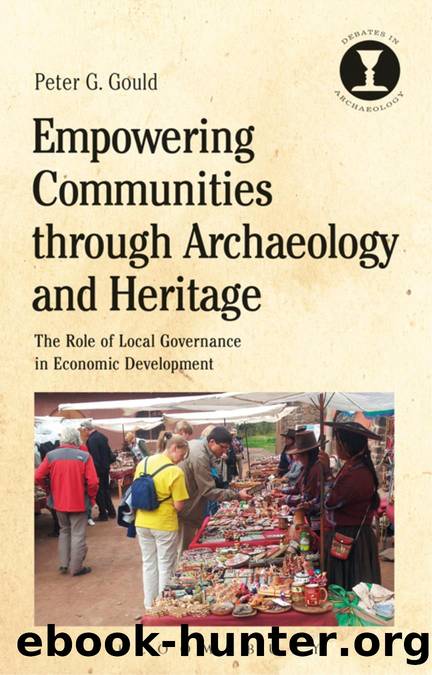Empowering Communities Through Archaeology and Heritage: The Role of Local Governance in Economic Development by Peter G. Gould

Author:Peter G. Gould [Gould, Peter G.]
Language: eng
Format: epub
Tags: Social Science, Archaeology, anthropology, General, history, Ancient
ISBN: 9781350036246
Google: 61BDDwAAQBAJ
Publisher: Bloomsbury Publishing
Published: 2018-01-25T00:00:02.476525+00:00
The Maya Centre Womenâs Group
As tourists began to visit the CBWS in hopes of seeing jaguars or other animals (the park harbors several other species of cats, tapirs, many rare birds, and other important fauna), villagers perceived an economic opportunity in the tourist traffic. Several men in the village, drawn largely from the Quam Bank residents who knew the jungle well, were trained and received government certification to serve as guides for visitors. The village also produced textile embroidery or slate and wood carvings that were presented to tourists as traditional crafts. As tourists started to arrive, villagers describe their children bolting from their chairs in school to rush to flag down passing cars in hope of selling home-made items. Led by their chairman, Saqui, the villagers concluded that a solution was needed to exploit the tourist trade without sacrificing their childrenâs education.
Despite initial resistance from the men in the village, in 1987 Saqui obtained agreement from the villagers to create the Maya Centre Womenâs Group to sell crafts for all of the traditional artisans in the village. Women were given the lead because most men were leaving the village every day to find work. For five years, Saqui coached the group in accounting, business management and problem solving, which produced the unusual operating procedures of the womenâs group, before he stepped back to leave the women to run the group on their own.
A small, thatch roofed oval building constructed in the Maya style was erected in 1984 to house the groupâs craft offerings. It was located at the intersection of the CBWS access road and the Southern Highway. When an entrance charge to access Cockscomb was established in 1987, the BAS authorized the MCWG to sell tickets and offered the group 10 percent of the proceeds from tickets they sold. Although not the only place tickets are available, in 2013, 60 percent of the tickets to enter the sanctuary were sold at the womenâs group shop.
Although a village dispute led to an arson fire at the thatched building within the first year, it was quickly rebuilt and within a few years twenty women were involved in the cooperative. In 2002, the original building was replaced with a larger cement structure financed by a grant of 40,000 Belize dollars from the European Union that was matched by 15,000 Belize dollars from the womenâs groupâs funds. In 2009, the facility was expanded again, with 30,000 Belize dollar grant from the womenâs groupâs funds, to house a roadside restaurant that was outfitted through a grant from the European Commission.
Forty women are members of the womenâs group, representing the majority of the villageâs fifty or so households. Open from 8 am to 5 pm every day, the MCWG shop caters to a traffic to CBWS of around 10,000 visitors per year. The MCWG has several sources of income, including their 10 percent share of CBWS ticket sales, a 10 percent share of the proceeds from membersâ craft sales that is retained by the
Download
This site does not store any files on its server. We only index and link to content provided by other sites. Please contact the content providers to delete copyright contents if any and email us, we'll remove relevant links or contents immediately.
| Africa | Americas |
| Arctic & Antarctica | Asia |
| Australia & Oceania | Europe |
| Middle East | Russia |
| United States | World |
| Ancient Civilizations | Military |
| Historical Study & Educational Resources |
Never by Ken Follett(2887)
The Man Who Died Twice by Richard Osman(2301)
Machine Learning at Scale with H2O by Gregory Keys | David Whiting(2294)
Fairy Tale by Stephen King(2073)
Will by Will Smith(2045)
Rationality by Steven Pinker(1768)
The Dawn of Everything: A New History of Humanity by David Graeber & David Wengrow(1571)
The Dark Hours by Michael Connelly(1571)
Principles for Dealing With the Changing World Order: Why Nations Succeed and Fail by Ray Dalio(1380)
Friends, Lovers, and the Big Terrible Thing by Matthew Perry(1333)
A Short History of War by Jeremy Black(1300)
HBR's 10 Must Reads 2022 by Harvard Business Review(1257)
Go Tell the Bees That I Am Gone by Diana Gabaldon(1237)
Can't Hurt Me: Master Your Mind and Defy the Odds - Clean Edition by David Goggins(1230)
515945210 by Unknown(1210)
Fear No Evil by James Patterson(1111)
443319537 by Unknown(1075)
Works by Richard Wright(1020)
Going There by Katie Couric(993)
